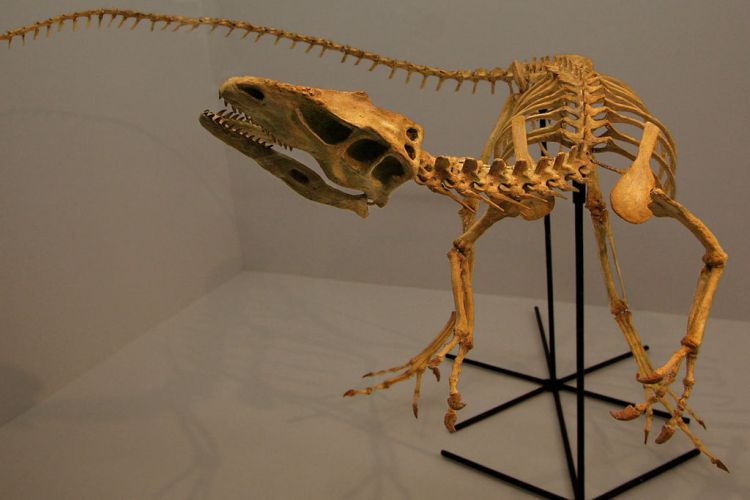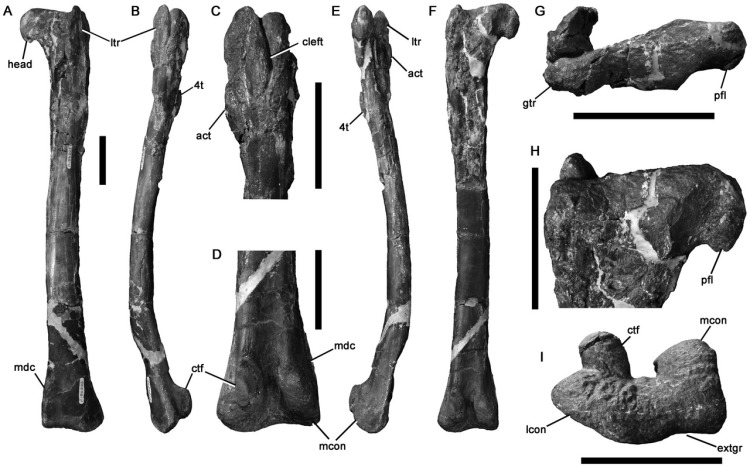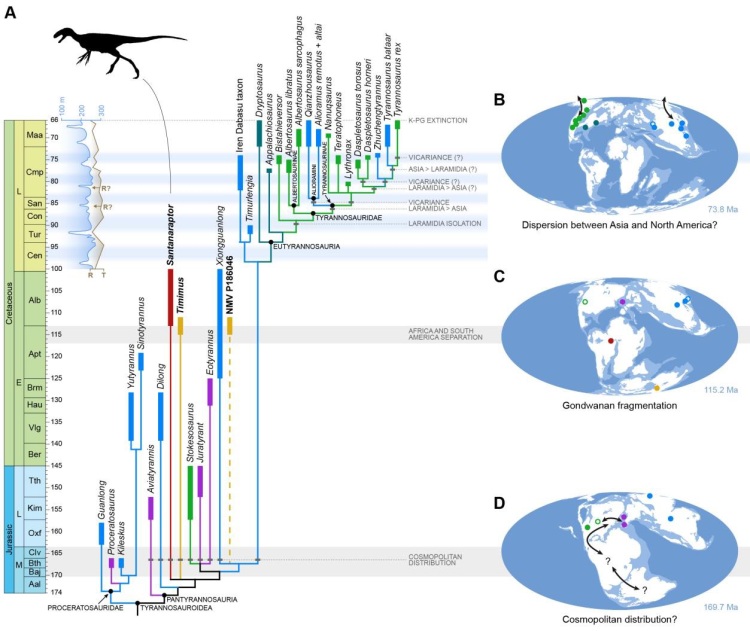
Santanaraptor lived in South America during the Early Cretaceous about 112 million years ago (From Wikimedia Commons).
Tyrannosauroidea, the superfamily of carnivorous dinosaurs that includes the iconic Tyrannosaurus rex, was mainly distributed in the Northern Hemisphere. However, a few specimens from Australia (Timimus hermani and the articulated pubes NMV P186046) and Brazil (Santanaraptor placidus), have been referred to this clade.
Santanaraptor was unearthed in 1996 in the Romualdo Group (Santana Formation). The holotype is a juvenile partial skeleton that may have reached 1.25 metres (4.1 ft) in length, and it was presumed to be similar to Dilong and Guanlong. It was first described as a coelurosaurian theropod by Alexander Kellner in 1999, but in 2014 Thomas Holtz classified Santanaraptor as the first tyrannosauroid known from Gondwana. Delcourt and Grillo (2018), also placed Santanaraptor within Tyrannosauroidea based on the following features: the absence of an accessory ridge on the lateral surface of the cnemial crest; the absence of a horizontal groove across the astragalar condyles anteriorly; a deep fossa on the medial surface of the femoral head, lateral to the trochanteric fossa; an ischial medial apron positioned along the anterior margin of its shaft in medial view; the lesser trochanter and the greater trochanter extending to approximately the same level proximally; the proximal margin of the femur is concave in posterior view due to a greater trochanter that is elevated substantially relative to the lateral portion of the proximal surface of the head; and a shallow femoral extensor groove on the anterior surface of the distal end that is expressed as a broad concave anterior margin in distal view but present as an extensive depression on the anterior surface of the femur.

Holotypic left femur of Timimus hermani (From Wikimedia Commons)
Timimus was unearthed in 1994 from Eumeralla Formation and shares similar features with Tyrannosauroidea, but due to the incompleteness of the Timimus holotype, is difficult to properly evaluate its phylogenetic position. The same applies to NMV P186046. It was suggested (Benson et al., 2012) that NMV P186046 and the Timimus holotype may represent a single taxon given their similar phylogenetic positions and congruent sizes, although they did not come from the same site.

Time-calibrated phylogeny of Tyrannosauroidea. From Delcourt and Grillo, 2018.
Tyrannosauroidea had a Eurasian distribution, but basal lineages of the newly proposed clade, Pantyrannosauria (the most inclusive clade, containing Tyrannosaurus rex and Dilong paradoxus, but not Proceratosaurus bradleyi), were distributed across Europe (Juratyrant, Eotyrannus and Aviatyrannis), North America (Stokesosaurus), South America (Santanaraptor), Australia (Timimus), and Asia (Dilong and Xiongguanlong). It was hypothesized that all basal lineages of Pantyrannosauria were already established in the Late Jurassic before the complete separation of Gondwana and Laurasia.
The fact that Santanaraptor and Timimus were relatively small suggests that Gondwanan tyrannosauroids remained small in comparison to northern species. The presence of Santanaraptor in a semi-arid environment with marine incursion also suggests that tyrannosauroids were not only found in humid paleoenvironments.
References:
Rafael Delcourt, Orlando Nelson Grillo , Tyrannosauroids from the Southern Hemisphere: Implications for biogeography, evolution, and taxonomy. Palaeo (2018), doi: 10.1016/j.palaeo.2018.09.003
Apesteguía, S., Smith, N.D., Juárez Valieri, R., Makovicky, P.J., 2016. An Unusual New Theropod with a Didactyl Manus from the Upper Cretaceous of Patagonia, Argentina. PLoS One 11, 1–41. doi:10.1371/journal.pone.0157793
Benson, R.B.J., Rich, T.H., Vickers-Rich, P., Hall, M., 2012. Theropod fauna from southern Australia indicates high polar diversity and climate-driven dinosaur provinciality. PLoS One 7, e37122. doi:10.1371/journal.pone.0037122
Porfiri, J. D., Novas, F. E., Calvo, J. O., Agnolín, F. L., Ezcurra, M. D. & Cerda, I. A. 2014. Juvenile specimen of Megaraptor (Dinosauria, Theropoda) sheds light about tyrannosauroid radiation. Cretaceous Research 51: 35-55. https://doi.org/10.1016/j.cretres.2014.04.007
Holtz Jr, T.R., 2004. Tyrannosauroidea, in: Weishampel, D.B., Dodson, P., Osm (Eds.), The Dinosauria. University of California Press, Berkeley, pp. 111–136.
It should be addressed that, five days before the online release of Delcout & Grillo (2018), a fire broke out in the Museu Nacional at the Universidade Federal do Rio de Janeiro, destroying roughly 90% of its collection. The paleontological specimens, including the holotype of Santanaraptor placidus (MNRJ 4802-V), are believed to be lost forever. Though casts of the Santanaraptor partial skeleton exist in other museums (as is the case with many MNRJ specimens), the purported soft issue anatomy of the hindleg will likely never be examined again.
A free-to-edit spreadsheet of all MNRJ paleontological type specimens, including info on surviving casts that could serve as pblastotypes, is here:
https://docs.google.com/spreadsheets/d/1s6pUek8dimHUHdq1tc59RsGymBpxmXRzyGEwFabtIAQ/edit?usp=sharing_eip&ts=5b8e7e3e
Pingback: Fossil Friday Roundup: September 21, 2018 | PLOS Paleo Community